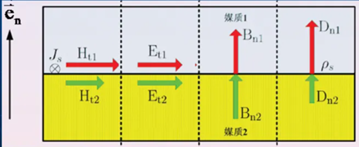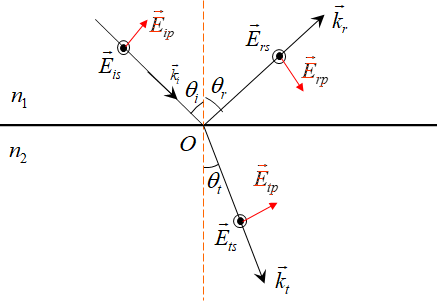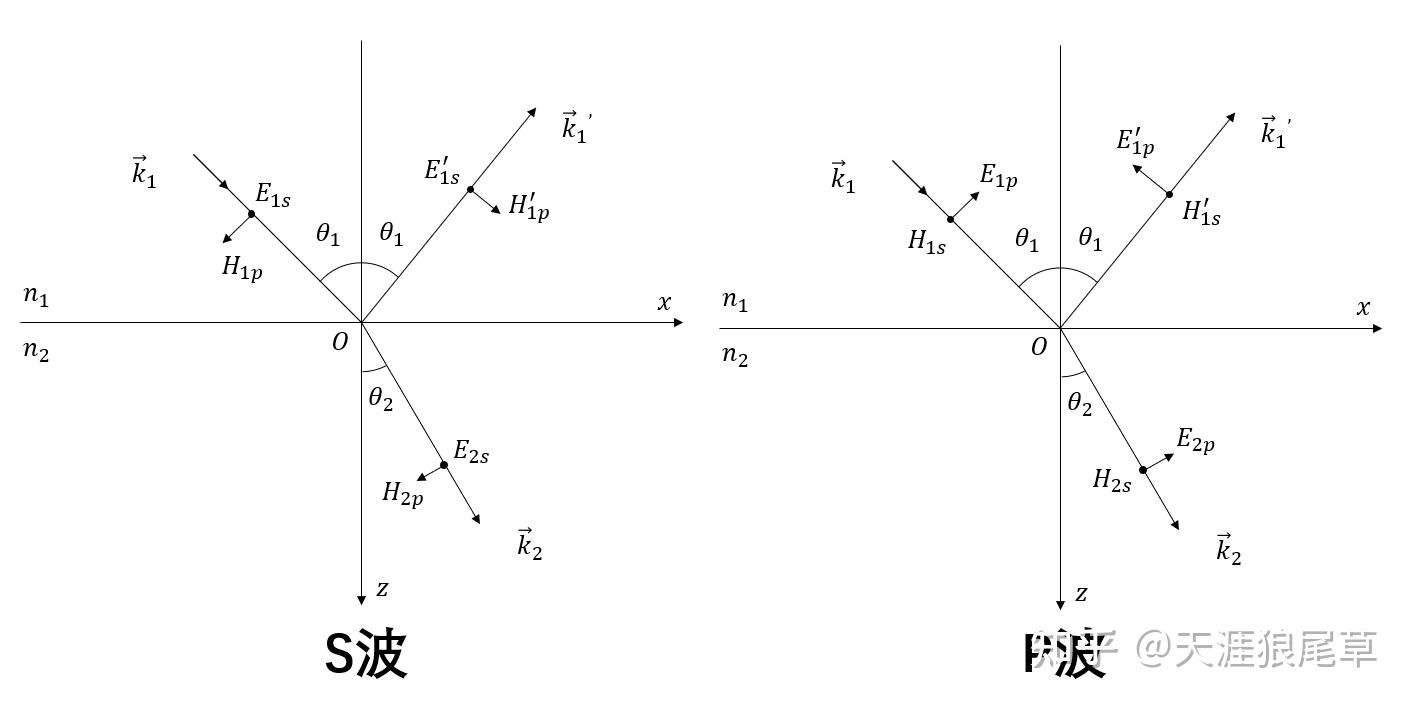电磁波与辐射
电偶极子
振荡的电偶极子:外界能量激发下,正负电中心不在一起,距离产生变化,并伴随着交变的电磁场->能量传递
电偶极子作简谐振荡时,电偶极矩p=p0e−iωt
远离电偶极子中心的点M处的场为:
E=4πϵv2r3ω2(r×p0)×rexp[i(kr−ωt)]
E=4πϵv3r2ω2(r×p0)exp[i(kr−ωt)]
从中可以观测到两者的关系为:
E=rv(B×r)
实际光波
波列是一种相速度基本相同,传播方向相同的波的叠加,在任意时刻,可以用周期函数来描述。谐波 是用调和函数来描述的无限延伸波列。
实际光波是在时空中存在衰减振动,并且波列是由原子间的碰撞产生的(例如激光上下能级跃迁),存在时间约≤10−8s,且不存在偏振特性
目前所称的光波,是指在T时刻内接收的光波列的组合,振动方向和相位被平均。
辐射能
电磁波的传播伴随能量的传递,空间中区域的单位体积辐射能称为能量密度 ,可表示为:
ω=21(E⋅D+H⋅B)=21(ϵE2+μ1B2)
能流密度是指单位时间内垂直通过的单位面积的能量,用于描述电磁场能量的传播,用坡印廷矢量 表示:
S=ωv=μ1E×B
光强为:I=⟨s⟩=21μϵA2
在同一均匀介质下 ,两点的场强的相对强度可用A的平方表示,当使用复振幅表示时为:
I=E~⋅E~∗
光在介质分界面上的折射和反射
连续性条件
电磁波由一种介质传导到另一种介质,折射率的改变导致电磁场在界面上不连续。在无源场的界面上,磁感应强度B和电感应强度D法向分量连续;磁场强度E和电场强度H切向分量连续。

菲涅尔公式与折反射
通常把垂直于入射面振动的分量叫做s分量 ,把平行于入射面(在入射面内)振动的分量称做p分量 ,如图所示。


从连续性条件可知:
Eis+Ers=Ets
Hipcosθi−Hrpcosθr=Htpcosθt
His+Hrs=Hts
Eipcosθi−Erscosθr=Etscosθt
通过H=μn(k0×E),可得到
rs=AisArs=EisErs=n1/μ1∗cosθ1+n2/μ2∗cosθ2n1/μ1∗cosθ1−n2/μ2∗cosθ2
ts=AisAts=EisEts=n1/μ1∗cosθ1+n2/μ2∗cosθ22∗n1/μ1∗cosθ1
rp=AipArp=EipErp=n2/μ2∗cosθ1+n1/μ1∗cosθ2n2/μ2∗cosθ1−n1/μ1∗cosθ2
tp=AipAtp=EipEtp=n2/μ2∗cosθ1+n1/μ1∗cosθ22∗n1/μ1∗cosθ1
当两种介质都为电介质时,一般考虑非磁性物质情况,认为磁导率相同,即:μ1=μ2,可进一步简化上式:
rs==n1cosθ1+n2cosθ2n1cosθ1−n2cosθ2=−sin(θ1+θ2sin(θ1−θ2)
ts=n1cosθ1+n2cosθ22n1cosθ1=sin(θ1+θ2)2sinθ2cosθ1
rp==n2cosθ1+n1cosθ2n2cosθ2−n1cosθ1=tan(θ1+θ2tan(θ1−θ2)
ts=n2cosθ1+n1cosθ22n1cosθ1=sin(θ1+θ2)cos(θ1−θ2)2sinθ2cosθ1
简化方法为同时除以n2,然后通过折射定律替换成展开的两角和公式。
折反射的偏振(振幅)与相位





